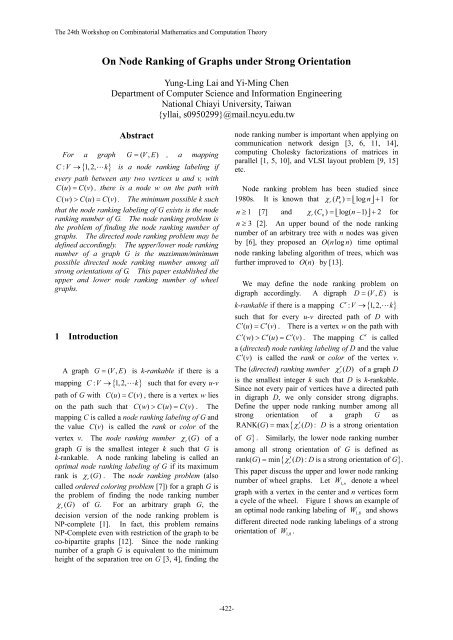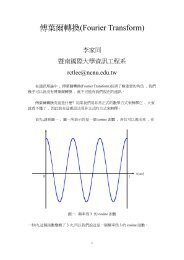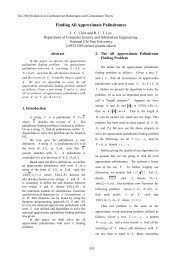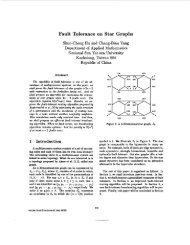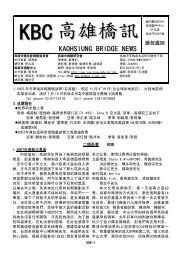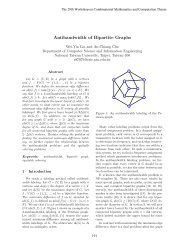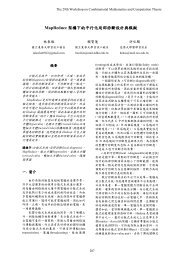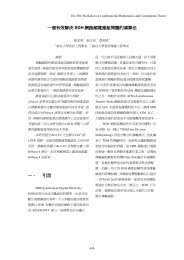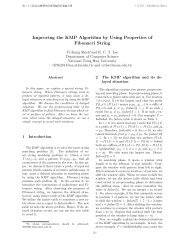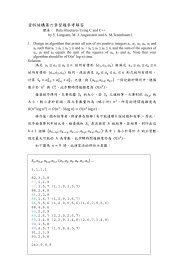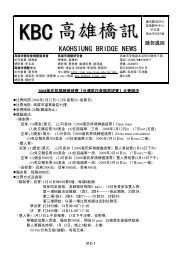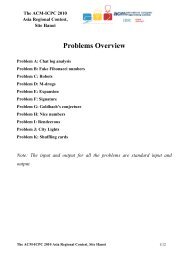On Node Ranking of Graphs under Strong Orientation
On Node Ranking of Graphs under Strong Orientation
On Node Ranking of Graphs under Strong Orientation
Create successful ePaper yourself
Turn your PDF publications into a flip-book with our unique Google optimized e-Paper software.
The 24th Workshop on Combinatorial Mathematics and Computation Theory<strong>On</strong> <strong>Node</strong> <strong>Ranking</strong> <strong>of</strong> <strong>Graphs</strong> <strong>under</strong> <strong>Strong</strong> <strong>Orientation</strong>Yung-Ling Lai and Yi-Ming ChenDepartment <strong>of</strong> Computer Science and Information EngineeringNational Chiayi University, Taiwan{yllai, s0950299}@mail.ncyu.edu.twAbstractFor a graph G ( V, E), a mappingC: V 1,2, k is a node ranking labeling ifevery path between any two vertices u and v, withCu ( ) Cv ( ), there is a node w on the path withCw ( ) Cu ( ) Cv ( ). The minimum possible k suchthat the node ranking labeling <strong>of</strong> G exists is the noderanking number <strong>of</strong> G. The node ranking problem isthe problem <strong>of</strong> finding the node ranking number <strong>of</strong>graphs. The directed node ranking problem may bedefined accordingly. The upper/lower node rankingnumber <strong>of</strong> a graph G is the maximum/minimumpossible directed node ranking number among allstrong orientations <strong>of</strong> G. This paper established theupper and lower node ranking number <strong>of</strong> wheelgraphs.1 IntroductionA graph G ( V, E)is k-rankable if there is amapping C: V 1,2, ksuch that for every u-vpath <strong>of</strong> G with Cu ( ) Cv ( ), there is a vertex w lieson the path such that Cw ( ) Cu ( ) Cv ( ) . Themapping C is called a node ranking labeling <strong>of</strong> G andthe value Cv () is called the rank or color <strong>of</strong> thevertex v. The node ranking number r( G)<strong>of</strong> agraph G is the smallest integer k such that G isk-rankable. A node ranking labeling is called anoptimal node ranking labeling <strong>of</strong> G if its maximumrank is r( G). The node ranking problem (alsocalled ordered coloring problem [7]) for a graph G isthe problem <strong>of</strong> finding the node ranking numberr( G)<strong>of</strong> G. For an arbitrary graph G, thedecision version <strong>of</strong> the node ranking problem isNP-complete [1]. In fact, this problem remainsNP-Complete even with restriction <strong>of</strong> the graph to beco-bipartite graphs [12]. Since the node rankingnumber <strong>of</strong> a graph G is equivalent to the minimumheight <strong>of</strong> the separation tree on G [3, 4], finding thenode ranking number is important when applying oncommunication network design [3, 6, 11, 14],computing Cholesky factorizations <strong>of</strong> matrices inparallel [1, 5, 10], and VLSI layout problem [9, 15]etc.<strong>Node</strong> ranking problem has been studied since1980s. It is known that r( Pn) logn 1forn 1 [7] and r( Cn) log( n1) 2forn 3 [2]. An upper bound <strong>of</strong> the node rankingnumber <strong>of</strong> an arbitrary tree with n nodes was givenby [6], they proposed an <strong>On</strong> ( log n ) time optimalnode ranking labeling algorithm <strong>of</strong> trees, which wasfurther improved to <strong>On</strong> ( ) by [13].We may define the node ranking problem ondigraph accordingly. A digraph D ( V, E)isk-rankable if there is a mapping C : V 1,2, ksuch that for every u-v directed path <strong>of</strong> D withC( u) C( v). There is a vertex w on the path withC( w) C( u) C( v). The mapping C is calleda (directed) node ranking labeling <strong>of</strong> D and the valueC () v is called the rank or color <strong>of</strong> the vertex v.The (directed) ranking number r( D)<strong>of</strong> a graph Dis the smallest integer k such that D is k-rankable.Since not every pair <strong>of</strong> vertices have a directed pathin digraph D, we only consider strong digraphs.Define the upper node ranking number among allstrong orientation <strong>of</strong> a graph G asRANK( G) max r( D) : D is a strong orientation<strong>of</strong> G . Similarly, the lower node ranking numberamong all strong orientation <strong>of</strong> G is defined asrank( G) min r( D) : Dis a strong orientation <strong>of</strong> G.This paper discuss the upper and lower node rankingnumber <strong>of</strong> wheel graphs. Let W1,ndenote a wheelgraph with a vertex in the center and n vertices forma cycle <strong>of</strong> the wheel. Figure 1 shows an example <strong>of</strong>an optimal node ranking labeling <strong>of</strong> W1,8and showsdifferent directed node ranking labelings <strong>of</strong> a strongorientation <strong>of</strong> W1,8.-422-
The 24th Workshop on Combinatorial Mathematics and Computation TheoryW1,8W1,81321W 1,8132 11221535122112411241Figure 1: <strong>Node</strong> ranking labelings on undirected and strong orientations <strong>of</strong> W1,8.2 Main resultsLemma 1: [2] The node ranking number <strong>of</strong> a cycleCnis r( Cn) lgn 1.Since the only strong orientation <strong>of</strong> a cycle iseither a clockwise or counterclockwise directed cycle,by lemma 1, theorem 2 comes trivial.Lemma 2: Let G Cnbe a cycle on n vertices.Then the upper and lower node ranking numberRANK( G) rank( G) lgn 1.Given H be a subgraph <strong>of</strong> G, since every u-v path inH must be a u-v path in G, but not the reverse, wehave following proposition:Proposition 1: Let H be a subgraph <strong>of</strong> G. Then ( H ) ( G).rrSimilar to the undirected graph, digraphs have thesame proposition which is stated as proposition 2.Proposition 2: Let H be a subgraph <strong>of</strong> D. Then( H ) ( D).rrLemma 3: The node ranking number <strong>of</strong> a wheelW1,nis r( W1,n) lgn 2.Pro<strong>of</strong>Let vcdenote the center vertex <strong>of</strong> W1,nandV { v , v ,..., v } denote the vertices on the cycle <strong>of</strong>n1 2nthe wheel. To see that r( W1,n) lgn 2,suppose to the contrary, r( W1,n) lgn 1. LetC: V( W1,n) 1,2, , lgn1be an optimal noderanking labeling <strong>of</strong> W1,n. Since v cis adjacent tovifor all v i V n, we have Cv (c) Cv (i),vi Vn.Since every pair <strong>of</strong> vertices v , v withijCv (i) Cv (j), vi-vc-v jis a path in W 1,n, withoutloss <strong>of</strong> generality, we may have Cv (c) lgn1which implies Cv (i) lgn for all vi Vn.Consider the subgraph Cn W1,n vc, letC : V( Cn) 1,2, , lgnbe a labeling definedas C( vi) C( vi)for all v i V n. Then C is anode ranking labeling <strong>of</strong> C nwith maximum ranklg n , which implies r( Cn) lgn contradictsto Lemma 1. Hence r( W1,n) lgn 2. Nowconsider a labeling f : V( W1,n) 1,2, lgn2 which labels Vn { v1, v2,..., vn} by an optimalnode ranking labeling <strong>of</strong> C and labels the vertexvcas lg n 2 . Then f is a node ranking labeling<strong>of</strong> W1,nwith maximum rank lg n 2 whichimplies r( W1,n) lgn 2. Hence we haver( W1,n) lgn 2. Since each directed path P in a strong orientation D<strong>of</strong> graph G is a path in G, if f is an optimal noderanking <strong>of</strong> D then f must be a node ranking labeling<strong>of</strong> G. Hence we have proposition 3 as follows.Proposition 3: Let G be a graph and D be anorientation <strong>of</strong> G. Then ( D) ( G).Since the adjacent vertices may not have the samerank, lemma 4 is trivial.Lemma 4: The node ranking number <strong>of</strong> completegraph is r( Kn) n . For any tournament D withn vertices, r( D) n .Lemma 5: [8] Le G be a graphC: V( G) {1,2, k}be an optimal node rankinglabeling <strong>of</strong> G . Then i,1i k , there is a vertexv V( G)such that Cv () i.rnr-423-
The 24th Workshop on Combinatorial Mathematics and Computation TheoryTheorem 1 Let G W1,nbe a wheel graph.Then RANK( G) lgn 2.Pro<strong>of</strong> Similar to Lemma 3, let v cdenote thecenter vertex <strong>of</strong> G and Vn { v1, v2,..., vn} denote thesuburb vertices which form a cycle on the wheel.By lemma 3 and proposition 3, we haveRANK( G) lgn 2. Consider an orientation D<strong>of</strong> G which makes Vn { v1, v2,..., vn}to be adirected cycle and let v chave both out-neighborsand in-neighbors, then D is a strong orientation <strong>of</strong> G.Consider the same labeling f as in lemma 3 on D, it isa node ranking labeling <strong>of</strong> D with maximum ranklg n 2 which implies r( D) lgn 2. Bylemma 2 and lemma 5, since Vn[ D ] is a directedcycle which has at least lg n 1ranks and v cisadjacent with v ifor all v i V n, for any directednode ranking labeling C <strong>of</strong> D, we must haveC( v ) C( v ), v V , which implies C mustc i i nhave at least lg n 2 ranks. Then we haveRANK( G) r( D) lgn 2. Hence,RANK( G) lgn 2. Theorem 2 Let G W1,nbe a wheel graph.Then3 if n is even,rank( G) 4 if n is odd.Pro<strong>of</strong>: For even n, consider an orientation D1<strong>of</strong>G such that viis adjacent to vi1,vi 1where i isodd, 1 i n. vjis adjacent to v cfor all evenj, 2 j n, and vcis adjacent to vifor all odd i,1 i n. Then D1is a strong orientation <strong>of</strong> G.Consider a labeling C which ranks Cv (c) 3 ,Cv (i) 1 for all vi Vn, i is odd; andCv (j) 2 for all v j V n, j is even. Then C isa directed node ranking labeling <strong>of</strong> D1withmaximum rank 3, which impliesrank( G) r( D1) 3. Since G contains K3as asubgraph, by lemma 4 and proposition 2, wehave rank( G) r( K3) 3 which give usrank( G) 3 for even n.For odd n, consider an orientation D 2<strong>of</strong> G suchthat viis adjacent to v i1and vi 1where i isodd and 1 i n. vjis adjacent to v cfor alleven j, 2 j n , and v cis adjacent to v ifor allodd i, 1 i n, and the edge vv1 nmay be orientedeither way. Then D2is a strong orientation <strong>of</strong> G.Consider a labeling C which ranks Cv (c) 4Cv (n) 3 , Cv (i) 1 for all v i V n, i n andi is odd; and Cv (j) 2 for all v j V n, j iseven. Then C is a node ranking labeling <strong>of</strong> D 2with maximum rank 4, which impliesrank( G) r( D2) 4. Since V nis odd, and theadjacent vertices can not have the same rank, thereare at least 3 ranks have to be used in V n. SinceVccan not have the same rank with any vertex inVn, a directed node ranking labeling <strong>of</strong> anyorientation <strong>of</strong> G, must use at least 4 ranks. Then wehave rank( G) 4, hence rank( G) 4. 3 ConclusionThe node ranking problem <strong>of</strong> graphs may beextended to digraphs. This paper defined thedirected node ranking number and established bothupper and lower node ranking number <strong>of</strong> wheelgraphs among all strong orientations.References[1] H.L. Bodlaender, J.R. Gilbert, H.Hafsteninsson and T. Kloks, “Approximatingtreewidth, pathwidth, frontsize and shortestelimination tree,” Journal <strong>of</strong> Algorithms 18, pp.238-255, 1995.[2] E. Bruoth and M. Horák, “<strong>On</strong>-line rankingnumber for cycles and paths,” DiscussionesMathematicae, Graph Theory 19, pp. 175-197,1999.[3] P. de la Torre, R. Greenlaw, A.A. Schäffer,“Optimal ranking <strong>of</strong> trees in polynomial time,”Proceedings <strong>of</strong> the 4th Annual ACM-SIAMSymposium on Discrete Algorithms, pp.138-144, 1993.[4] J.S. Deogun, T. Kloks, D. Kratsch, and H.Muller, “<strong>On</strong> vertex ranking for permutationand other graphs,” Proc. <strong>of</strong> the 11th AnnualSymposium on Theoretical Aspects <strong>of</strong>Computer Science, P. Enjalbert, E.W. Mayr,K.W. Wagner, Lecture Notes in ComputerScience 775, Springer-Verlag, Berlin, pp.747-758, 1994.[5] I.S. Duff and J.K. Reid, “The multifrontalsolution <strong>of</strong> indefinite sparse symmetric linearequations,” ACM Transactions onMathematical S<strong>of</strong>tware 9 (1983), pp. 302-325.[6] A.V. Iyer, H.D. Ratliff and G. Vijayan,“Optimal node ranking <strong>of</strong> trees,” Inform.Process. Lett. 28 225~229, 1988.-424-
The 24th Workshop on Combinatorial Mathematics and Computation Theory[7] M. Katchalski, W. McCuaig, and S. Seager,“Ordered colorings,” Discrete Mathematics142, pp. 141-154, 1995.[8] Yung-Ling Lai, Yi-Ming Chen, March 1-3,2007, “<strong>On</strong> <strong>Node</strong> <strong>Ranking</strong> <strong>of</strong> Complete r-partite<strong>Graphs</strong>”, International Conference onMathematics and Computer Science, Chennai,India.[9] C.E. Leiserson, “Area-efficient graph layouts(for VLSI),” Proceedings <strong>of</strong> the 21st AnnualIEEE Symposium on Foundations <strong>of</strong> ComputerScience, pp. 270-281, 1980.[10] J.W.H. Liu, “The role <strong>of</strong> elimination trees inspare factorization,” SIAM Journal <strong>of</strong> MatrixAnalysis and Applications 11, pp. 134-172,1990.[11] J. Nevins, D. Whitney (Eds.), “ConcurrentDesign <strong>of</strong> Products and processes,”McGraw-Hill, New York, 1989.[12] A. Pothen, “The complexity <strong>of</strong> optimalelimination trees,” Technical Report CS-88-13,Pennsylvania State University, University Park,PA, 1988.[13] A. A. Schäffer, “Optimal node ranking <strong>of</strong> treesin linear time,” Information Processing Letters33, pp. 91-96, 1989.[14] P. Scheffler, “<strong>Node</strong> ranking and searching oncographs (Abstract),” in: U. Faigle and C.Hoede (Eds.), 3rd Twente Workshop on Graphand Combinatorial Optimization, 1993.[15] A. Sen, H. Deng, and S. Guha, “<strong>On</strong> a graphpartition problem with application to VLSIlayout.” Information Processing Letters 43, pp.87-94, 1992.-425-


